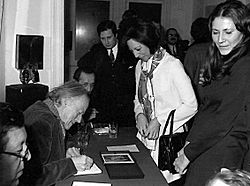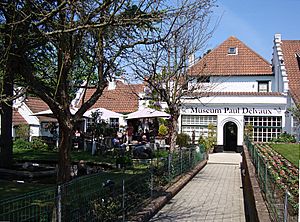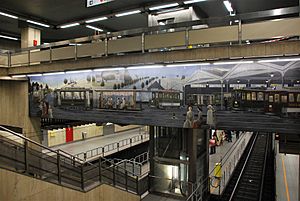Paul Delvaux facts for kids
Quick facts for kids
Paul Delvaux
|
|
|---|---|

Paul Delvaux signing autographs (1972), Brussels, Belgium
|
|
| Born | 23 September 1897 Antheit, Belgium
|
| Died | 20 July 1994 (aged 96) Veurne, Belgium
|
| Nationality | Belgian |
| Education | Académie Royale des Beaux-Arts |
| Known for | Painting, Frescos |
|
Notable work
|
Sleeping Venus (1944) Hommage a Jules Verne (1971) |
| Spouse(s) | Suzanne Purnal (m. 1937, div. 1948) Anne-Marie "Tam" de Maertelaere (m. 1952, d. 1989) |
Paul Delvaux (born September 23, 1897 – died July 20, 1994) was a famous Belgian painter. Many people consider him a surrealist artist. Surrealism is an art style that mixes real things with dream-like or strange ideas. Even though he was influenced by other surrealists like Giorgio de Chirico and René Magritte, Paul Delvaux created his own unique style. He combined the detailed beauty of classical art with the surprising and unusual scenes of surrealism.
Contents
Early Life and Art Education
Paul Delvaux was born on September 23, 1897, in Antheit, Belgium. His parents lived in Brussels, but his mother went to her own mother's house for his birth. His father was a successful lawyer, and his mother was a musician. She was a very strong presence in his life.
As a young boy, Delvaux studied Greek and Latin. He loved reading the adventure stories of Jules Verne and the ancient Greek poem Odyssey by Homer. These stories greatly influenced his early drawings, which often showed scenes from mythology. He also had music lessons in a school museum room, where a human skeleton was always present in a glass cabinet. This skeleton would later appear in his paintings.
From 1910 to 1916, he studied Classics. After graduating, his parents wanted him to work in an office. But Paul had no interest in business or law. He really wanted to be a painter. His parents finally allowed him to study architecture at the Académie Royale des Beaux-Arts (Royal Academy of Fine Arts) in Brussels.
In 1916, he started at the Académie. He struggled with math and left after his first year. Feeling unsure about his future, he started copying postcards. His mother told him to paint from nature. In 1919, he created his first watercolors, which were mostly landscapes.
While on vacation in 1919, he met the painter Franz Courtens. Courtens saw Delvaux's watercolors and told his parents that their son had great talent. He encouraged Paul to return to the Académie to study painting. This time, his parents agreed.
In 1919, Delvaux went back to the Académie. He studied with famous painters like Constant Montald and Jean Delville. During this time, his paintings were mainly realistic landscapes. He also completed his mandatory military service while studying art.
Paul Delvaux's Artistic Career
At first, Delvaux was inspired by 19th-century French and Belgian academic painting. This style focused on detailed and traditional art. Between 1920 and 1925, he painted about 80 artworks. His early paintings were often dark landscapes or city scenes, like Les cheminots de la gare du Luxembourg (Railroad Workers of Luxembourg Station, 1922).
In 1924, he set up his own art studio at his parents' house in Brussels. In 1925, he had his first art show in Brussels.
In the late 1920s and early 1930s, Delvaux's paintings were influenced by Flemish Expressionist artists. These artists used strong colors and brushstrokes to show feelings. Many of his paintings from this time have been lost. Delvaux himself destroyed about 50 of his canvases to reuse the frames.
In 1929, Delvaux met Anne-Marie de Maertelaere, whom he called "Tam." They fell in love. However, his mother made him promise not to see her again. This made Delvaux very sad, and his paintings started to show more isolated and lonely feelings.
Around 1933, his style changed. He was influenced by the "metaphysical art" of Giorgio de Chirico. This art style often showed strange scenes in empty, dream-like settings. Delvaux's paintings started to feature women in fancy clothes, set in classical ruins or dark forests.
In the mid-1930s, Delvaux also began to use ideas from his fellow Belgian artist, René Magritte. Magritte was known for painting ordinary objects in surprising ways. Delvaux respected Magritte's work, but their relationship was not always easy.
Delvaux admitted his influences. He said that de Chirico showed him "what was possible, the climate that had to be developed, the climate of silent streets with shadows of people who can't be seen."
In 1934, Delvaux showed his work alongside Salvador Dalí, de Chirico, and Magritte in an exhibition in Brussels. In 1936, he and Magritte had separate successful shows.
Even though Delvaux was part of the Belgian surrealist group for a while, he didn't fully see himself as a "Surrealist." He believed his art was deeply connected to his childhood memories and imagination.
On January 16, 1937, his father passed away. In July of that year, Delvaux married Suzanne Purnal. He later said it was a marriage of convenience. He made his first trip to Italy, which inspired him. Soon, mermaids and ocean scenes began to appear in his art.
Between 1937 and 1941, Delvaux perfected his unique artistic style.
When Germany invaded Belgium in 1940, Delvaux stayed home and continued to paint. His painting La ville inquiète (Anxious City, 1941) shows the worries and strange routines of wartime.
Delvaux often visited the Museum of Natural Sciences in Brussels to sketch human skeletons. In 1943, he started painting skeletons in lifelike poses, sometimes interacting with each other.
After the war, Delvaux continued to create many important works that made him famous. In January 1945, he had a big art show in Brussels with 57 large paintings.
In 1947, a gallery in New York City showed Delvaux's paintings, and critics liked them.
In August 1947, Delvaux met Tam again by chance. They started their close relationship once more. The next year, Delvaux divorced his first wife and moved in with Tam. In 1951, they built a small house and studio by the coast. They married on October 25, 1952, and stayed together until Tam's death in 1989.
From 1950 to 1962, Delvaux taught "monumental painting" at an art school in Brussels. In the 1950s, he painted a series of crucifixions and deposition scenes using skeletons. Some of his paintings from this time used very few colors, focusing more on lines.
In the late 1950s, he started painting night scenes with trains. A little girl in a dress often watches the trains from behind. These paintings had a dream-like feeling because of the clear, moonlit details. Trains were always special to Delvaux, reminding him of the wonder he felt seeing the first electric trams as a child.
Delvaux also created large wall murals. In 1952, he helped paint a mural in Ostend, Belgium, showing a Roman dancing scene with a large mermaid. In 1958, he led a team to paint La Carte littéraire de Belgique (Literary Map of Belgium) for the 1958 Brussels World’s Fair. This huge painting showed a map of Belgium with places connected to famous writers.
In 1963, he became vice-director of the Académie Royale de Belgique, and then its president in 1965.
In 1969, Delvaux moved to Veurne, but still spent a lot of time at his studio.
In the 1970s and 1980s, Delvaux's eyesight slowly got worse. His paintings became less detailed and more colorful. His later works focused more on female figures, often in groups, interacting with each other.
In 1978, he helped create a large fresco mural called Nos vieux trams bruxellois (Our Old Brussels Trams) in a Brussels Metro station.
That same year, the Paul Delvaux Foundation was created to build a museum for his art.
In 1981, Delvaux met Andy Warhol, who made several portraits of the older artist. On June 26, 1982, the Paul Delvaux Museum opened in Saint-Idesbald. It has the world's largest collection of Delvaux's paintings, drawings, and prints.
In 1986, Delvaux painted his last canvas, called Calypso.
His beloved wife, Tam, passed away in 1989. After this, Delvaux stopped creating art completely. He died in Veurne on July 20, 1994, and was buried next to Tam.
Paul Delvaux's Style and Themes
Paul Delvaux usually painted very carefully and thoughtfully. He often made many drawings and studies before starting a major painting. He would also change his paintings as he worked, erasing or moving elements to make them perfect. Because he was such a perfectionist, he only completed about 450 paintings during his 60-year career.
His paintings often show everyday scenes under the moonlight or classical ruins. These settings feature strange and dream-like situations with very clear details. Sometimes, Delvaux would even paint himself into the scene. You can often spot mirrors, the full or crescent moon, candles, books, and flute players in his art.
Delvaux repeated these themes throughout his long career. However, some changes can be seen, like his paintings from 1945–1947, which used a flatter style and unusual perspectives.
The way the viewer looks at his paintings is important. He often used unusual viewpoints, windows, or mirrors. Lines, whether straight man-made ones or the curves of a body, were often more important than the quiet colors he used.
While his painted figures often seem cool and distant, Delvaux's smaller drawings and sketches more often show figures touching and interacting closely.
Here are some themes that appear again and again in Paul Delvaux's art:
- Trains, Trams, and Stations: He loved trains and often included them in his night scenes.
- Architectural Elements: You'll see ancient Greek or Roman buildings, ruins, and parts of early 20th-century city structures.
- A Tribute to Women: Women are everywhere in his art. They often look distant and focused on something else. They wear gauze, feathers, flowers in their hair, or fancy jewelry.
- The Place of Men: Men in his paintings often seem lost in thought, old-fashioned, or even silly. Delvaux sometimes painted himself. Other male characters include ordinary men in suits, or characters from Jules Verne's novels, like a geologist or an astronomer.
- Skeletons as Architecture of Life: Delvaux used human skeletons in a surprising way. For him, they represented life itself, not just death.
Honours
- 1958: Became a member of the Royal Academy of Science, Letters and Fine Arts of Belgium.
Images for kids
See also
 In Spanish: Paul Delvaux para niños
In Spanish: Paul Delvaux para niños
- List of Belgian painters






